

The film series Telling Time is grounded on that characteristic of images and sounds that allows for the transformation of time into duration and the paradox that opposes memory’s fixed points to the flow of things.
The series is composed of several movies and the pathways between them seeking to reflect on the issue of time in film. The films are direct records of time’s experience, laments for its passage, recording and capturing what is both permanent and transient time in human activity (and its consequences), in the Earth’s cycles, in the various chronologies of work, objects and sites.
In its manifest relation with time, film creates first and foremost an experience of the tangible materiality of its passage: a duration, a sense of weight and density that can only be diluted in the all-consuming – out of time – vastness. It is an idea of film, fleeting and possible; film that both freezes time in a discernible bloc and asserts its transience, opening cracks and raising obstacles to its flow through its own poetics and mechanisms. These films portray the memory of things, of making objects; they are mythological fictions, snapshots of distant places and the traces of time lingering therein.
session 1 —
02 OCT | 21:30 | DR. FÉLIX RIBEIRO THEATRE
BRITANNICA
by John Latham. Great-Britain, 1971 - 6 min. / 16 mm / no dialogue
SPIRAL JETTY
by Robert Smithson. United States, 1970 - 32 min / 16 mm
CASTING A GLANCE
by James Benning. United States, 2007 - 80 min / 16 mm / no dialogue
BRITANNICA, the short-length film that opens this session, challenges the speed at which we read and assimilate the content of the famous encyclopaedia, questioning the notion of time. It is followed by two visual studies of Spiral Jetty, a seminal land art piece built by Robert Smithson on the bank of Utah’s Great Salt Lake in 1970. Directed by Smithson himself, the first film details the evolution of “jetty”, touching upon a series of key aspects of his work. Benning, a great admirer of Smithson, will return to that motif 37 years later, revealing what the passing of time has meant for this piece. However, contrary to our expectations, CASTING A GLANCE is distinguished by the fact that, under the guise of recording real time of extended duration, it constructs an imaginary time that simulates the flow of time.

SPIRAL JETTY / ROBERT SMITHSON / © COLECÇÃO CINEMATECA PORTUGUESA - MUSEU DO CINEMA
session 2 —
07 OCT | 22:00 | LUÍS DE PINA THEATRE
LA RÉGION CENTRALE
by Michael Snow. Canada, 1971 - 180 min / 16 mm / no dialogue
In a deserted region of Canada, a camera, guided by a mechanical arm, turns incessantly in all directions, recording at different speeds, the surrounding landscape. In what consists his best-known film, director Michael Snow takes the concept of cinema’s automatism a step further, embodied here in the shape of a veritable “automatic eye” that carries out a painstaking depiction of the landscape.
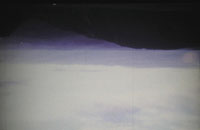
LA RÉGION CENTRALE / MICHAEL SNOW / CORTESIA DO ARTISTA, LUX LONDON
session 3 —
09 OCT | 22:00 | LUÍS DE PINA THEATRE
TUDZHI (THE FURNACE)
by Otar Iosseliani. Soviet Union, 1964 - 20 min / 35 mm / no dialogue
LES RENDEZ-VOUS DU DIABLE
by Haroun Tazieff. France, 1959 - 80 min / 35 mm
The visual qualities of molten metal and the overpowering melancholy of this curious film also characterize TUDZHI, a documentary that portrays the brutal activity of a iron-steel factory in the Georgian town of Rustavi. In LES RENDEZ-VOUS DU DIABLE, third variation on the subject of fire and flames, volcanologist Haroun Tazieff fixes his attention on the beauty of some of the most famous active volcanoes in Europe.
session 4 —
13 OCT | 19:30 | LUÍS DE PINA THEATRE
TUTUGURI – TARAHUMARAS 79
by Raymonde Carasco and Régis Hébraud. France, 1980 - 25 min / 16 mm
EKSOPRAGMATICO (OUT OF REALITY)
by Stavros Tornes. Screenplay: Stavros Tornes, Charlotte van Gelder; Image: Stavros Tornes; Montage: Stavros Tornes, Charlotte van Gelder; Sound: Nico d’Alessandria; Music: Charlotte van Gelder. Italy, 1979 - 40 min / 16 mm
BALAMOS
by Stavros Tornes. with Stavros Tomes, Salil Salil, Kyriakos Vilanakis, Enzo Attingenti, Christos Karagoutas, Helen Maniati, Mitsos Angelakopoulos, Constantine Pangalos. Greece, 1982 - 82 min / 35 mm (shot in 16 mm)
An introduction to the Tutuguri ritual, repeated six times in a controlled time sequence, in addition to the words of Antonin Artaud, by which “starting from one shot, montage manages to build the two opposing ends of real time and space-time, expanded from a double subject matter: Tutuguri and Carreras (male races, called “ball races” and female or “hoop” races, specific to the Tarahumara people, whose etymology asserts as “of the running feet” (Raymonde Carasco). EKSOPRAGMATICO, the last film directed by Stavros Tornes in Italy before his return to Greece, is a lament on the passage of time, while BALAMOS returns to this issue by casting a gaze over a time-less time. Balamos is a man wondering in a fantastic world where any form of time-keeping or chronology has become pointless. We dedicate this session to the memory of Raymonde Carasco, who passed away last March.
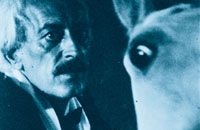
BALAMOS / STAVROS TORNES
session 5 —
15 OCT | 21:30 | DR. FÉLIX RIBEIRO THEATRE
AM SIEL
by Peter Nestler. Germany, 1962 - 13 min / 16 mm
L’ITINÉRAIRE DE JEAN BRICARD
by Jean-Marie Straub and Danièle Huillet. France, 2008 - 40 min / 35mm
AM SIEL, Peter Nestler’s first film, is guided by a rather unconventional voice – that of an old dam – which tells the story of its country. Jean Bricard was born in 1932 in Basse-Pierre, in the Loire. Before he retired in 1992, he was the head of a company that extracted sand in Ile Verte, facing Ancenis (in the Atlantic Loire). L’Itinéraire by Jean Bricard was shot on February 24, 1994, following two interviews on the story of his life published by Jean-Yves Petiteau, a researcher at CNRS, in the magazine of the École de Beaux-Arts de Nantes, Interlope la curieuse, n.º 9-10, June 1994.
L’ITINÉRAIRE DE JEAN BRICARD is a record, a reflection on the land and territory, a lesson in History and a ghost story... Cinema, it has been said, is the last form of oral history and this film work, it is literally so. In an island on the Loire there was once life, people who worked, fought on, produced wine and lived off the river. The film is a heart-warming testimony of what remains to be seen and experienced, and about the way space turns into time.
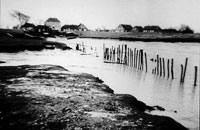
AM SIEL / PETER NESTLER / © PETER NESTLER
session 6 —
16 OCT | 19:30 | LUÍS DE PINA THEATRE
LA ROSIÈRE DE PESSAC 79
by Jean Eustache. France, 1979 - 67 min / 16 mm
LA ROSIÈRE DE PESSAC 68
by Jean Eustache. France, 1968 - 65 min / 16 mm
Eustache filmed the traditional celebration of the town he was born, Pessac, in the manner of direct cinema, first in 1968 and then again in 1979: known as La Rosière de Pessac, the celebration is a ritual that dates back to the 17th century, involving the community in the choice of the most virtuous local girl, a title she will hold for one year, until the ritual is repeated and a new choice is made. Eleven years after the first version, LA ROSIÈRE DE PESSAC 68, LA ROSIÈRE DE PESSAC 79 recounts both French history from the observation of a micro-cosmos and the fascination of the director for ceremonials. In an interview to Cahiers du Cinéma, in 1979, Eustache expressed a programming wish that this sessions retrospectively brings back: “I would like both films to be shown together: first the one from 79, followed by the one from 68.” That is exactly what we will do.
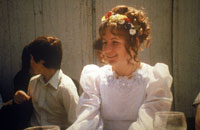
LA ROSIÈRE DE PESSAC 79 / JEAN EUSTACHE / © COLECÇÃO CINEMATECA PORTUGUESA - MUSEU DO CINEMA
session 7 —
20 OCT | 19:30 | LUÍS DE PINA THEATRE
AM SIEL
by Peter Nestler. Germany, 1962 - 13 min / 16 mm
MÜLHEIM/RUHR
by Peter Nestler. Germany, 1964 - 14 min / 16 mm
VÄNTAN (A ESPERA)
by Peter Nestler. Sweden, 1985 - 6 min / 16 mm
DIE NORDKALOTTE (THE POLAR CAP)
by Peter Nestler. Germany, 1990-91 - 90 min / 16 mm
This programme consists of a set of short films directed by one of the most interesting current German documentary filmmakers. AM SIEL is driven by an unconventional voice – that of an old dam - that tells the story of its country. In MÜLHEIM/RUHR, Nestler takes us on a journey through the Ruhr region, whose montage highlights the contrast between life in the working class neighbourhoods and the irruption of something new. VÄNTAN departs from a series of photo images as a tribute to the victims of a mining accident in Silesia. In DIE NORDKALOTTE, the filmmaker distances himself from his home country and points a finger at the disastrous effects of industrialization on the forests, lakes and people of Lapland. Outspokenly politicized, this set of films cry out against neglect and abandonment and assert the need for change.
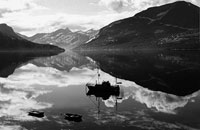
DIE NORDKALOTTE / PETER NESTLER / © PETER NESTLER
session 8 —
21 OCT | 22:00 | LUÍS DE PINA THEATRE
SEM NEN KIZAMI NO HIDOKEI: MAGINOMURA MONOGATARI
(MAGINO VILLAGE: A TALE)
by Shinsuke Ogawa. with Hijikata Tatsumi, Miyashita Junko, Tamura Takahiro, Kawarasaki Choichiro, Ishibashi Renji. Japan, 1986 - 222 min / 16 mm / English subtitles
Invited by the local dwellers, the Ogawa collective established themselves in the Magino village and with them cultivated the rice fields while recording its collective memory, rendering it through filming the testimonies of the village elders, who perpetuate this oral tradition from generation to generation, or event fictional re-enactments. This unique and complex film is the result of the work undertaken by the Ogawa collective throughout thirteen years of a community experiment in the rice fields that surround Magino village. The unveiling of a daily life and community history, whose rhythm is echoed in the very pace of the film itself.

SEN NEN KIZAMI NO HIDOKEI: MAGINOMURA MONOGATARI / OGAWA SINSUKE / 1986
session 9 —
23 OCT | 19:30 | LUÍS DE PINA THEATRE
FAREWELL TOPSAILS
by Humphrey Jennings. Great Britain, 1937 - 9 min / 35 mm
LES VOITURES D’EAU
by Pierre Perrault. Canada, 1969 - 110 min / 35 mm
FAREWELL TOPSAILS is a nostalgic documentary that captures the disappearance of sailing boats, accompanied by the progressive replacement of production means seen as ancient by industrialized means. LES VOITURE D’EAU focuses on another type of boat menaced likewise by the changing times: small vessels made by hand by the dwellers of Ile-aux-Coudres that constitute their primary means of transportation.
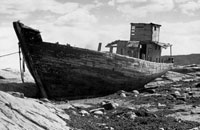
LES VOITURES D’EAU / PIERRE PERRAULT / © COLECÇÃO CINEMATECA PORTUGUESA - MUSEU DO CINEMA
session 10 —
27 OCT | 22:00 | LUÍS DE PINA THEATRE
EUREKA
by Ernie Gehr. USA, 1974 - 30 min / 16 mm
HELSINKI, IKUISESTI (HELSINKI, FOREVER)
by Peter von Bagh. Finland, 2008 - 75 min / BETA SP
EUREKA is based on the re-shooting of a silent movie depicting Market Street in San Francisco in the turning of the 20th century. Gehr, a leading North-American filmmaker, will breath new life into this long sequence shot recorded from a moving tramway, by prolonging its duration in photograms and by intensifying contrasts in the image. Resorting to existing material, Peter van Bagh’s film is a portrait of Helsinki and its history based on edited excerpts of countless Finnish films covering roughly one hundred years. Like two archaeological surveys, these works resurrect both other film material and the shadows and powers at play in bygone days.
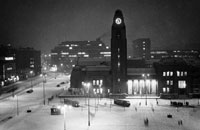
HELSINKI FOREVER / PETER VON BAGH / © CITY OF HELSINKI CITY MUSEUM
session 11 —
28 OCT | 22:00 | LUÍS DE PINA THEATRE
BOSTON FIRE
by Peter Hutton. USA, 1979 - 8 min / 16 mm / silent
NEW YORK NEAR SLEEP FOR SASKIA
by Peter Hutton. USA, 1972 - 10 min / 16 mm / silent
NEW YORK PORTRAIT II
by Peter Hutton. USA, 1980-81 - 16 min / 16 mm / silent
IN TITAN’S GOBLET
by Peter Hutton. USA, 1991 - 10 min / 16 mm / silent
STUDY OF A RIVER
by Peter Hutton. USA, 1996-97 - 16 min / 16 mm / silent
TIME AND TIDE
by Peter Hutton. USA, 2000 - 35 min / 16 mm / silent
A session comprising six contemplative portraits of different landscapes, made by a filmmaker whose aesthetic choices come close to fixed images. Using juxtapositions of shadow and motion, NEW YORK NEAR SLEEP FOR SASKIA examines the subtle light variations in the city; BOSTON FIRE explores the beauty of the dark clouds arising from a ranging fire while NEW YORK PORTRAIT II is the second part of a detailed picture of New York. Leaving behind urban landscapes, IN TITAN’S GOBLET constitutes a homage to the landscape painting of Thomas Cole. STUDY OF A RIVER, in turn, is the first part of a larger study on the river Hudson filmed in the course of two years, an endeavour that will continued in TIME AND TIDE, the first part of which is based in the photos taken by Billy Bitzer.
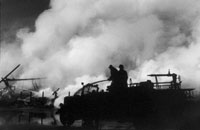
BOSTON FIRE / PETER HUTTON / © PETER HUTTON
session 12 —
30 OCT | 22:00 | LUÍS DE PINA THEATRE
KEEP IN TOUCH
by Jean-Claude Rousseau. France, 1987 - 25 min / 16 mm / no dialogues
LES ANTIQUITÉS DE ROME
by Jean-Claude Rousseau. France, 1984–89 - 105 min / 16 mm / no dialogues
Two films that engage the passage of time within a set of fixed frames. In KEEP IN TOUCH we find the filmmaker sitting in a room in New York, in a moment of waiting. LES ANTIQUITÉS DE ROME shows how in each place, each room, each monument has its own geography. A lyrical film work on the duration of time, whose intensity is amplified and threatened by its original medium, Super 8 mm.
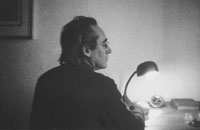
KEEP IN TOUCH / JEAN-CLAUDE ROUSSEAU / © COLECÇÃO CINEMATECA PORTUGUESA - MUSEU DO CINEMA













